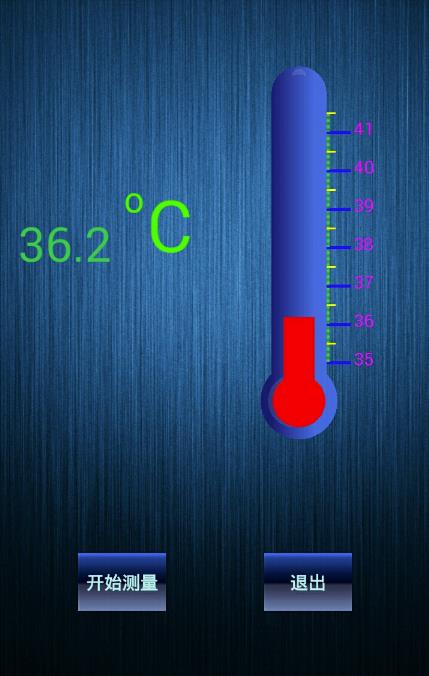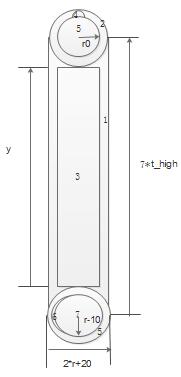本文实例为大家分享了Android实现动态体温计的具体代码,供大家参考,具体内容如下
前段时间在做一个生理参数采集的项目,其中涉及到体温模块。这是我的部分总结。
实现内容: 从文件中读取体温数据,动态绘制体温的效果。即体温数据随时间在不停的变化。体温计绘制效果为立体效果。

实现原理:
1、体温计的绘制

绘制原理:
体温计的大体框架由图1,2,4,5,6,7构成,绘制通过自定义View,DrawView的onDraw()方法来实现,体温计水银柱的的绘制通过SurfaceView来实现。根据屏幕宽度来设定体温计大小及位置。
图1,2,6构成体温计玻璃管,由颜色Color.argb(255, 25, 25, 112)和颜色Color.argb(250, 65,105,225)从左往右一次填充,实现渐变。图3是动态矩形,为体温计水银柱,由Color.RED和Color.argb(250, 255, 255, 0)有下往上填充,实现红色到橙色的渐变。图8为体温计水银柱头部,用红色填充。图4,5组合形成光晕,图4由Color.argb(30, 250, 250, 250)填充,图5填充颜色与体温计玻璃管相同。先绘制图4再绘制图5,于是,便形成月牙形光晕。图7为光晕,由Color.argb(30, 250, 250, 250)填充。然后画出刻度线,这样便制作出具有立体感的体温计。感觉底座部分设计的不大好,立体感不强。
动态刷新原理:将从文件中的体温数据读取,存储到数组当中,绘制体温时,根据数据来确定中间红色水银柱的坐标,其实,也就是动态矩形的绘制,采用定时绘制的方法实现动态效果。
原理说的差不多了,我们来看下代码实现过程:
布局文件:textView用来显示数值,surfaceView用来绘制动态矩形。
temp.xml
<&#63;xml version="1.0" encoding="utf-8"&#63;>
体温计绘制View代码段:
import android.content.Context;
import android.graphics.Canvas;
import android.graphics.Color;
import android.graphics.LinearGradient;
import android.graphics.Paint;
import android.graphics.RectF;
import android.graphics.Shader;
import android.util.DisplayMetrics;
import android.view.View;
public class DrawTemp extends View{
private float wide;
private float high;
private float t_wide;
private float t_high ;
private float r; //半径大小
private float x0;//圆心坐标
private float x1;
private float y0;
private float y1;
/*自定义颜色*/
private int color_blue = Color.argb(255, 25, 25, 112);
private int color_bule1 = Color.argb(250, 65,105,225);
private int color_white = Color.argb(30, 250, 250, 250);
private int color_white1 = Color.argb(60, 250, 250, 250);
private int color_orange = Color.argb(250, 255, 255, 0);
public DrawTemp(Context context) {
super(context);
// TODO 自动生成的构造函数存根
Paint paint = new Paint();
paint.setColor(Color.YELLOW);
}
protected void onDraw(Canvas canvas)
{
DisplayMetrics dm = new DisplayMetrics();
dm = getResources().getDisplayMetrics();
wide = dm.widthPixels; // 屏幕宽(像素,如:480px)
high = dm.heightPixels; // 屏幕高(像素,如:800px)
t_wide = wide/20;
t_high = high/20;
r = t_high-10;
x0 = wide/2+2*t_wide;
x1 = wide/2+4*t_wide;
y0 = t_high*2;
y1 = 10*t_high;
float ydegree = 9*t_high;
int min_temp = 35; //最低温度为35
int m1 = 4;
int Line1_size = 1;
int Line2_size = 3;
int Line3_size = 5;
//设置最小大刻度线条参数
Paint paintLine1 = new Paint();
paintLine1.setColor(Color.BLUE);
paintLine1.setStrokeWidth(Line3_size);
//设置中等刻度线条参数
Paint paintLine2 = new Paint();
paintLine2.setColor(Color.YELLOW);
paintLine2.setStrokeWidth(Line2_size);
//设置最小刻度线条参数
Paint paintLine3 = new Paint();
paintLine3.setColor(Color.GREEN);
paintLine3.setStrokeWidth(Line1_size);
//设置文字参数
Paint text = new Paint();
text.setColor(Color.MAGENTA);
text.setTextSize(30);
Paint mPaint = new Paint();
mPaint.setStrokeWidth(m1);
LinearGradient ng= new LinearGradient(x0-10, y0, x1-10, y0, color_blue,color_bule1, Shader.TileMode.CLAMP);
mPaint.setShader(ng);
canvas.drawRect(x0-10, y0, x1+10, y1, mPaint);//绘制外围矩形
canvas.drawCircle(x0+t_wide, y0, t_wide+10,mPaint );//绘制外围上部分圆弧
canvas.drawCircle(x0+t_wide, y1,r+10, mPaint);//绘制外围底座
//绘制水银柱
Paint nPaint = new Paint();
nPaint.setColor(Color.RED);
canvas.drawCircle(x0+t_wide, y1, r-10, nPaint);
//LinearGradient mg= new LinearGradient(x0+10, y1, x0-10, y0, Color.RED,color_orange, Shader.TileMode.CLAMP);
LinearGradient mg= new LinearGradient(x0+10, y1, x1-10, y0, Color.RED,color_orange, Shader.TileMode.CLAMP);
nPaint.setShader(mg);
//绘制动态矩形
// canvas.drawRect(x0+10, y, x1-10, y1, nPaint);
//绘制光晕,圆角矩形
Paint paint = new Paint();
paint.setColor(color_white);
RectF Rect = new RectF(x0-5, y0,x0+5, y1-t_high);
canvas.drawCircle(x0+t_wide, y0-t_wide/2-t_wide/3, t_wide/3,paint );
canvas.drawCircle(x0+t_wide, y0, t_wide-t_wide/8,mPaint );
canvas.drawCircle(x0+t_wide-8, y1, r-10, paint);
canvas.drawCircle(x0+t_wide, y1, r-10, nPaint);
paint.setColor(color_white1);
RectF Rect3 = new RectF(x0, y1, x0+t_wide, y1+t_wide);
canvas.drawArc(Rect3, 0, 30, false, paint);
while (ydegree > y0+30) {
canvas.drawLine(x1+10, ydegree, x1+15, ydegree, paintLine3);
if (ydegree % t_high == 0) {
canvas.drawLine(x1+10, ydegree, x1+50, ydegree, paintLine1);
canvas.drawText(min_temp + "", x1+55, ydegree + 5, text);
min_temp++;
}
else if(ydegree % (t_high/2) == 0)
{
canvas.drawLine(x1+10, ydegree, x1+25, ydegree, paintLine2);
}
ydegree = ydegree - 2 ;
}
}
}
主程序:
public void onCreate(Bundle savedInstanceState) {
super.onCreate(savedInstanceState);
setContentView(R.layout.temp_layout);
innit(); // 初始化
ActionBarUtils.initActionBar(getApplicationContext(), getActionBar(),
"体温");
timer = new Timer();
start.setOnClickListener(new OnClickListener()
{
@Override
public void onClick(View v) {
// TODO 自动生成的方法存根
timer= new Timer();
handler = new Handler()
{
@Override
public void handleMessage(Message msg)
{ //刷新图表
s = String.valueOf(min_data);
if(msg.what == 1)
{
text1.setText(s);
}
if(msg.what == 0)
{
String num = String.valueOf(number);
text1.setText(num);
}
else if(msg.what == 2)
{
text1.setText("爆表啦");
}
super.handleMessage(msg);
}
};
task = new TimerTask()
{
@Override
public void run()
{
Message message = new Message();
// drawPmThread pm = new drawPmThread();
if( min_data == number)
{
onDestroy();
}
if(number>40)
{
message.what = 2;
handler.sendMessage(message);
}
if(0
以上就是本文的全部内容,希望对大家的学习有所帮助,也希望大家多多支持。

 京公网安备 11010802041100号 | 京ICP备19059560号-4 | PHP1.CN 第一PHP社区 版权所有
京公网安备 11010802041100号 | 京ICP备19059560号-4 | PHP1.CN 第一PHP社区 版权所有